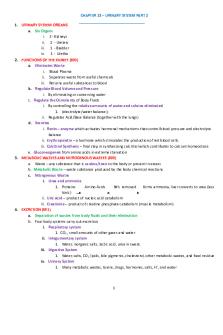Distributed System Notes PDF

| Title | Distributed System Notes |
|---|---|
| Author | Rohan Khurana |
| Course | bachelors in technology |
| Institution | Amity University |
| Pages | 2 |
| File Size | 58.8 KB |
| File Type | |
| Total Downloads | 105 |
| Total Views | 145 |
Summary
dwsxsadcds sdfvaedfqwedc dvadvade ewfefqadsc wdcqdsc wecqdsdv vqefvqervfv dfvqefdv dfvqaerg3v werft34rfgf frgdfhhr gqergwtrtgh fsfghstrhstrhv v bgbefwrg...
Description
Logical Clock Logical Clocks refer to implementing a protocol on all machines within your distributed system, so that the machines are able to maintain consistent ordering of events within some virtual timespan. A logical clock is a mechanism for capturing chronological and causal relationships in a distributed system.
Algorithm:
Happened before relation (->): a -> b, means ‘a’ happened before ‘b’.
Logical Clock: The criteria for the logical clocks are:
[C1]: Ci (a) < Ci(b), [ Ci -> Logical Clock, If ‘a’ happened before ‘b’, then time of ‘a’ will be less than ‘b’ in a particular process. ]
[C2]: Ci(a) < Cj(b), [ Clock value of Ci(a) is less than Cj(b) ]
Reference:
Process: Pi
Event: Eij, where i is the process in number and j: jth event in the ith process.
tm: vector time span for message m.
Ci vector clock associated with process Pi, the jth element is Ci[j] and contains Pi‘s latest value for the current time in process Pj.
d: drift time, generally d is 1.
Implementation Rules [IR]:
[IR1]: If a -> b [‘a’ happened before ‘b’ within the same process] then, Ci(b) =Ci(a) + d
[IR2]: Cj = max(Cj, tm + d) [If there’s more number of processes, then t m = value of Ci(a), Cj = max value between Cj and tm + d]
Vector Clock Vector Clock is an algorithm that generates partial ordering of events and detects causality violations in a distributed system. These clocks expand on Scalar time to facilitate a causally consistent view of the distributed system, they detect whether a contributed event has caused another event in the distributed system. It essentially captures all the causal relationships. This algorithm helps us label every process with a vector (a list of integers) with an integer for each local clock of every process within the system. So, for N given processes, there will be vector/ array of size N.
Limitations of Distributed System 1. Absence of a Global Clock: In a distributed system there are a lot of systems and each system has its own clock. Each clock on each system is running at a different rate or granularity leading to them asynchronous. In starting the clocks are regulated to keep them consistent, but only after one local clock cycle they are out of the synchronization and no clock has the exact time. Time is known for a certain precision because it is used for the following in distributed system:
Temporal ordering of events
Collecting up-to-date information on the state of the integrated system
Scheduling of processes
There are restrictions on the precision of time by which processes in a distributed system can synchronize their clocks due to asynchronous message passing. Every clock in distributed system is synchronize with a more reliable clock, but due to transmission and execution time lapses the clocks becomes different. Absence of global clock make more difficult the algorithm for designing and debugging of distributed system. 2. Absence of Shared Memory: Distributed systems have not any physically shared memory, all computers in the distributed system have their own specific physical memory. As computer in the distributed system do not share the common memory, it is impossible for any one system to know the global state of the full distributed system. Process in the distributed system obtains coherent view of the system but in actual that view is partial view of the system. As in distributed system there is an absence of a global state, it is challenging to recognize any global property of the system. The global state in distributed system is divided by many number of computers into smaller entities....
Similar Free PDFs

Distributed System Notes
- 2 Pages

Distributed system mcq 2018
- 25 Pages

Distributed Computing System MCQ
- 22 Pages

Distributed systems - Lecture notes 1
- 198 Pages

distributed computing question bank
- 34 Pages

IM Ch12 Distributed DBMS Ed12
- 14 Pages

Urinary System Lecture Notes
- 15 Pages

Operating system Notes
- 118 Pages

Ic6501 control system notes
- 212 Pages
Popular Institutions
- Tinajero National High School - Annex
- Politeknik Caltex Riau
- Yokohama City University
- SGT University
- University of Al-Qadisiyah
- Divine Word College of Vigan
- Techniek College Rotterdam
- Universidade de Santiago
- Universiti Teknologi MARA Cawangan Johor Kampus Pasir Gudang
- Poltekkes Kemenkes Yogyakarta
- Baguio City National High School
- Colegio san marcos
- preparatoria uno
- Centro de Bachillerato Tecnológico Industrial y de Servicios No. 107
- Dalian Maritime University
- Quang Trung Secondary School
- Colegio Tecnológico en Informática
- Corporación Regional de Educación Superior
- Grupo CEDVA
- Dar Al Uloom University
- Centro de Estudios Preuniversitarios de la Universidad Nacional de Ingeniería
- 上智大学
- Aakash International School, Nuna Majara
- San Felipe Neri Catholic School
- Kang Chiao International School - New Taipei City
- Misamis Occidental National High School
- Institución Educativa Escuela Normal Juan Ladrilleros
- Kolehiyo ng Pantukan
- Batanes State College
- Instituto Continental
- Sekolah Menengah Kejuruan Kesehatan Kaltara (Tarakan)
- Colegio de La Inmaculada Concepcion - Cebu






